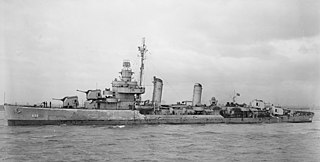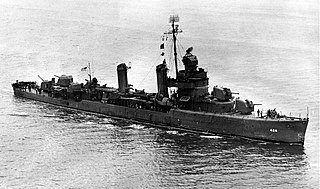
USS Hogan (DD-178/DMS-6) was a Wickes-class destroyer in the United States Navy during World War II.

USS Strong (DD-467), was a Fletcher-class destroyer and the first ship of the United States Navy to be named after Rear Admiral James H. Strong (1814–1882), who rammed the Confederate ironclad CSS Tennessee during the Battle of Mobile Bay, receiving a commendation and promotion to captain.

USS Livermore (DD-429), a Gleaves-class destroyer, was the 1st ship of the United States Navy to be named for Samuel Livermore, the first naval chaplain to be honored with a ship in his name.

USS Kearny (DD-432), a Gleaves-class destroyer, was a United States Navy warship during World War II. She was noted for being torpedoed by a German U-boat in October 1941, before the U.S. had entered the war. She survived that attack, and later served in North Africa and the Mediterranean.

USS Woolsey (DD-437), a Gleaves-class destroyer, was the second ship to be named Woolsey in the United States Navy. It is the first to be named for both Commodore Melancthon Brooks Woolsey and his father Commodore Melancthon Taylor Woolsey.

USS Ludlow (DD-438), a Gleaves-class destroyer, was the third ship of the United States Navy to bear the name. The second and third Ludlow ships were named for Lieutenant Augustus C. Ludlow, second in command of USS Chesapeake. He was, like his captain, mortally wounded in their ship's engagement with HMS Shannon on 1 June 1813, and died at Halifax, Nova Scotia on 13 June.

USS Nicholson (DD-442), a Gleaves-class destroyer, was the third ship of the United States Navy to be named for the Nicholson family, which was prominent in the early history of the Navy. The destroyer saw service during World War II in the Atlantic, Mediterranean and Pacific theaters. Following the war, the ship was placed in reserve and used as a training ship. In 1951, the destroyer was transferred to Italy and renamed Aviere. In service with the Marina Militare until 1975, Aviere was sunk as a target ship in 1975.

USS Tillman (DD-641), a Gleaves-class destroyer, was the second ship of the United States Navy to be named for United States Senator Ben Tillman. In commission from 1942 to 1947, she saw service in World War II, primarily in the Atlantic and Mediterranean.

USS Knight (DD-633), a Gleaves-class destroyer, is the only ship of the United States Navy to be named for Admiral Austin M. Knight.

USS Robinson (DD-562), a Fletcher-class destroyer, was the second ship of the United States Navy to be named for Captain Isaiah Robinson, who served in the Continental Navy.

USS Forrest (DD-461/DMS-24), was a Gleaves-class destroyer of the United States Navy.

USS Fitch (DD-462/DMS-25), was a Gleaves-class destroyer of the United States Navy.

USS Benson (DD-421) was the lead ship of her class of destroyers in the United States Navy during World War II. She was named for Admiral William S. Benson (1855–1932).

USS Hilary P. Jones (DD-427) was a Benson-class destroyer in the United States Navy during World War II. She was named for Admiral Hilary P. Jones.

USS Charles F. Hughes (DD-428) was a Benson-class destroyer in the United States Navy during World War II. She was named for Charles Frederick Hughes.

USS Boyle (DD-600) was a Benson-class destroyer in the United States Navy during World War II. She was the first ship named after Thomas Boyle, a privateer and naval officer during the War of 1812.

USS Champlin (DD-601) was a Benson-class destroyer in the United States Navy during World War II. She was the second ship named for Stephen Champlin.

USS Murphy (DD-603) was a Benson-class destroyer in the United States Navy during World War II. She was named for Lieutenant John McLeod Murphy.

USS McLanahan (DD-615) was a Benson-class destroyer in the United States Navy during World War II. She was the second Navy ship named for Tenant McLanahan.

USS Frederick C. Davis (DE-136) was an Edsall-class destroyer escort built for the United States Navy during World War II. It was the last US Naval vessel lost in the Battle of the Atlantic.




















